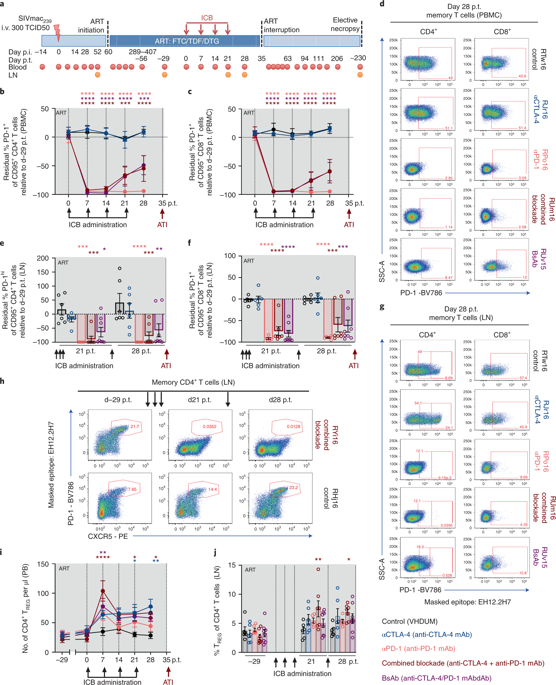Nature Medicine ( IF 58.7 ) Pub Date : 2020-03-16 , DOI: 10.1038/s41591-020-0782-y Justin Harper 1 , Shari Gordon 2, 3 , Chi Ngai Chan 4 , Hong Wang 1 , Emily Lindemuth 5 , Cristin Galardi 3, 6 , Shane D Falcinelli 3 , Samuel L M Raines 3 , Jenna L Read 3 , Kevin Nguyen 1 , Colleen S McGary 1 , Michael Nekorchuk 4 , Kathleen Busman-Sahay 4 , James Schawalder 3, 6 , Colin King 1 , Maria Pino 1 , Luca Micci 1 , Barbara Cervasi 1 , Sherrie Jean 7 , Andrew Sanderson 8 , Brian Johns 2, 3 , A Alicia Koblansky 3, 6 , Heather Amrine-Madsen 3, 6 , Jeffrey Lifson 9 , David M Margolis 3 , Guido Silvestri 1, 10 , Katharine J Bar 5 , David Favre 2, 3 , Jacob D Estes 4, 11 , Mirko Paiardini 1, 10

|
The primary human immunodeficiency virus (HIV) reservoir is composed of resting memory CD4+ T cells, which often express the immune checkpoint receptors programmed cell death protein 1 (PD-1) and cytotoxic T lymphocyte-associated protein 4 (CTLA-4), which limit T cell activation via synergistic mechanisms. Using simian immunodeficiency virus (SIV)-infected, long-term antiretroviral therapy (ART)-treated rhesus macaques, we demonstrate that PD-1, CTLA-4 and dual CTLA-4/PD-1 immune checkpoint blockade using monoclonal antibodies is well tolerated, with evidence of bioactivity in blood and lymph nodes. Dual blockade was remarkably more effective than PD-1 blockade alone in enhancing T cell cycling and differentiation, expanding effector-memory T cells and inducing robust viral reactivation in plasma and peripheral blood mononuclear cells. In lymph nodes, dual CTLA-4/PD-1 blockade, but not PD-1 alone, decreased the total and intact SIV-DNA in CD4+ T cells, and SIV-DNA and SIV-RNA in B cell follicles, a major site of viral persistence during ART. None of the tested interventions enhanced SIV-specific CD8+ T cell responses during ART or viral control after ART interruption. Thus, despite CTLA-4/PD-1 blockade inducing robust latency reversal and reducing total levels of integrated virus, the degree of reservoir clearance was still insufficient to achieve viral control. These results suggest that immune checkpoint blockade regimens targeting PD-1 and/or CTLA-4, if performed in people living with HIV with sustained aviremia, are unlikely to induce HIV remission in the absence of additional interventions.
中文翻译:

CTLA-4和PD-1双重阻断诱导SIV重新激活,且抗逆转录病毒治疗中断后无法控制反弹
人类免疫缺陷病毒(HIV)的初级储存库由静息记忆CD4 + T细胞组成,通常表达免疫检查点受体程序性细胞死亡蛋白1(PD-1)和细胞毒性T淋巴细胞相关蛋白4(CTLA-4),通过协同机制限制 T 细胞的激活。使用感染猿猴免疫缺陷病毒 (SIV) 并接受长期抗逆转录病毒疗法 (ART) 治疗的恒河猴,我们证明使用单克隆抗体进行 PD-1、CTLA-4 和双重 CTLA-4/PD-1 免疫检查点阻断效果良好耐受性好,有血液和淋巴结生物活性的证据。双重阻断在增强 T 细胞循环和分化、扩大效应记忆 T 细胞以及诱导血浆和外周血单核细胞中强劲的病毒再激活方面比单独的 PD-1 阻断明显更有效。在淋巴结中,双重 CTLA-4/PD-1 阻断(但不是单独的 PD-1)减少了 CD4 + T 细胞中的总和完整 SIV-DNA,以及 B 细胞滤泡中的 SIV-DNA 和 SIV-RNA,这是一个主要因素。 ART 期间病毒持续存在的部位。所测试的干预措施均未增强 ART 期间的 SIV 特异性 CD8 + T 细胞反应或 ART 中断后的病毒控制。因此,尽管 CTLA-4/PD-1 阻断诱导了强劲的潜伏期逆转并降低了整合病毒的总水平,但病毒库清除程度仍然不足以实现病毒控制。这些结果表明,针对 PD-1 和/或 CTLA-4 的免疫检查点阻断方案,如果在持续无病毒血症的 HIV 感染者中进行,在没有额外干预的情况下不太可能诱导 HIV 缓解。











































 京公网安备 11010802027423号
京公网安备 11010802027423号